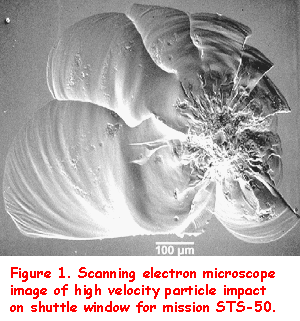![]()
|
Some of it floats in space; much of it orbits Earth. You can find it on the surfaces of Venus and Mars and twenty tons of it is actually parked on the Moon! Some call it space trash, others refer to it as space junk or space debris. All three terms identify the same items -- man-made objects remaining in space though they no longer serve any useful purpose. Mankindıs journey into space began in 1957 when the Soviet Union launched Sputnik, the first artificial satellite. Since that time more than 4,000 satellites have been launched into orbit. With so much traffic travelling into space, is it any wonder that a little trash has been left behind? |
It is estimated that hundreds of millions of pieces of space trash are now floating through our region of the solar system. Some of them are as large as trucks while others are smaller than a flake of paint. There are a couple of relatively famous pieces of space trash. One is the glove that floated away from the Gemini 4 crew during the first spacewalk by U.S. astronauts. The other is the camera Michael Collins lost during the Gemini 10 mission. Rocket boosters, pieces that came loose from spacecraft, and fragments and particles created by space collisions or explosions are other examples of the types of trash whizzing around Earth at speeds of up to 36,000 km per hour.
Earthıs gravitational field pulls a lot of space trash into lower and lower orbits until it finally reaches Earth's atmosphere. Most of the trash burns up when it enters Earthıs atmosphere. The higher the altitude at which it orbits the longer the space trash will remain in orbit. Space trash moving in orbits lower than 600 km normally falls back to Earth within a few years. Space trash orbiting at altitudes higher than 1,000 km can continue circling Earth for a century or more.

The main problem with space trash is the danger it poses to working satellites and manned spacecraft. NASA frequently replaces Space Shuttle windows damaged by orbiting flakes of paint! In Figure 1 above, you see an image of an impact crater found on a Shuttle window. The crater is about 1 millimeter in size and was caused by a "space trash particle" about 100 microns in size hitting the window at a high speed. More than likely, this particle came from a solid rocket motor burn.
Because of the very great speeds at which space trash travels, small pieces between 1 and 10 centimeters in size can penetrate and damage most spacecraft. A ten-centimeter long piece of space trash can cause as much damage as twenty-five sticks of dynamite! For these reasons, NASA (together with the Department of Defense) has created a space surveillance network. Ground stations track larger pieces of space trash so that collisions with working satellites or the Space Shuttle can be avoided. Future plans include a cooperative effort among the governments of many nations to stop littering space and to possibly clean up the trash already there. Who knows, an occupation for the near future might be as a space trash collector.
![]()
The StarChild site is a service of the High Energy Astrophysics Science Archive Research Center (HEASARC), within the Astrophysics Science Division (ASD) at NASA/ GSFC.
StarChild Authors: The StarChild Team
StarChild Graphics & Music: Acknowledgments
StarChild Project Leader: Dr. Laura A.
Whitlock
Curator:
Responsible NASA Official: